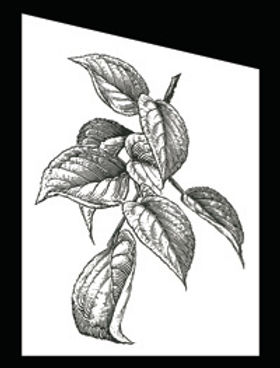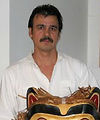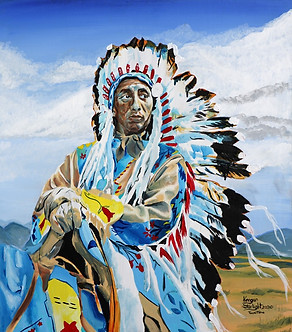Artists Awaiting Sponsorship
April Larkin
Metis
1850's Octopus Fire Bag Metis Beading Design
Metis people need to be acknowledged for their impact on Aboriginal Art. The Metis were famous for their floral beadwork and were often called the "Flower Beadwork People". As a Metis woman, my goal in this painting is to replicate the floral designs of the 1850's Red River Metis Octopus fire bag design. I am bringing new life to this art form using acrylic paint dots instead of beads, while still recreating the floral designs of yesteryear. Thereby creating a link between the past and the present.
Sponsor: Awaiting your sponsorship


April Mercredi
Metis
A Simple Prayer
The presence of a prayer sender is worked through with abstract, enmeshed with colour and mixed media. Followed gently by deep shadows and dark tones, depicting the thoughts, feelings and experiences of a past when culture and tradition were simple, raw and old. With each prayer sender, I therefore framed with gratitude of the mind, body and spirit and then left it to inner dreams.
Sponsor: Awaiting your sponsorship


Audra Schoblocher
"Ring the Bell" : A sculptural depiction of St. Paul’s Anglican church
Research on St. Paul’s Anglican church revealed that the building served as a school house as well as a place of worship. During the week, the children surrounding the Midnapore Hamlet were known to have walked or ridden their horses for many miles to attend classes at the small church between 1887 and 1891.
Local Anglican parishioners built St. Paul’s Fish Creek church in 1885 based on a similar church in Calgary, Scotland. The original chaple in Midnapore is known as Calgary’s oldest Anglican church which was declared a historical site in 1977 under the name, St. Paul’s Anglican church.
Sponsor: Awaiting your sponsorship


Carla Pelkey
OwLeaf
With the Great Horned Owl chosen for its spiritual symbolism and primarily featured, also included will be the wood frog, squirrel, insects and leaf vegetation, representing interdependent links and biodiversity. The image will be created with actual autumn leaves which will then be digitally captured and reproduced for the final piece.
Sponsor: Awaiting your sponsorship


Craig Johnson
Lone Wolf
The lone wolf is reflected in its natural setting, carved out of cottonwood, embraced between natural fir stumps, deemed to be over 1,000 years old and reclaimed from the Porcupine Hills in Southern Alberta by Kevin Nicholson of The Wood King in Black Diamond Alberta. Read more...
Sponsor: Awaiting your sponsorship


Derek Besant
Branch of Leaves
My image is a graphic depiction of trembling aspen leaves that grow in groves in the Southern Alberta foothills. The symbol of an element from nature that can be found in this region, speaks of growth and renewal. A sprig with leaves has endless connotations of offering, healing, life and connection. Black and white linear treatment accentuates the lines of the form and underlines the representational nature of the subject matter.
Sponsor: Awaiting your sponsorship


Diane Stearne
Cycle
Cycle is a celebration of the seasonal beauty found in Fish Creek Park. The rose hips embody the spirit of Spring, the Summer beauty of the Alberta Rose, and the bounty of that beauty found throughout the park in the Fall and Winter.
Sponsor: Awaiting your sponsorship


Dion Wesley
The Purifying Teaching
The practice of prayer through the teachings of spirituality for the local First Nations has been witnessed by these plants and trees of Fish Creek Park. The two ladies are Nakoda Sioux with their children smudging with sage grass for praying to the Great Spirit “Creator”, for good health and guidance. The beauty and peacefulness of the Park was silent enough for the prayers to be heard and witnessed by their children to learn from.
Sponsor: Awaiting your sponsorship


Eleanor Lowden Pigeon
Taking Care of Business
Fish Creek is a true gem for the city of Calgary. To have a provincial park within our city limits is pretty special. As an artist the park offers me many seasons of inspiration, as well as a tranquil escape from the nearby chaos of the city. I've painted an image of the original woollen mill that was one of the buildings erected by the Shaw family in the early 1900’s, and one of the many early uses of the land in Fish Creek. In addition to the mill, I've depicted some sheep in the foreground to bring some life to the painting. I worked in acrylic on panel.
Sponsor: Awaiting your sponsorship


Emil Thiebert
Sun Mask Plaque
This piece was traditionally carved from red cedar from the kuakulith tribe on the west coast of British Columbia. I enjoy doing sun masks because the sun represents the light. It brings life to the world. It is also one of my 'native names' given to me years ago and represents my children whom all have sun names as well (Sunshine, Sunset and Sunrise).
Sponsor: Awaiting your sponsorship


Keegan Starlight
Guusat
Keegan resides and works on the Tsuut’ina Nation southwest of Calgary and has been creating art in one form or another for nearly 20 years.
Art felt like a natural fit when he was in elementary school, and he understood it with an ease he hadn’t encountered in more rigid core subjects.
The cultures expressed through Starlight’s work span a diverse breadth of traditions and experiences, moving through Tsuut’ina, Blackfoot, Stoney, Dene, Ojibwe and Navaho.
Sponsor: Awaiting your sponsorship

June Hills
Trees in the Park
My artwork is a drawing of some of the engaging trees I have encountered in Fish Creek Provincial Park. These images were taken from my plein aire sketchbook of the Park, and illustrate the dynamic life cycle of the Park's trees. The Bow River and Fish Creek meander through their dance in the forest. Both the sketchbook and panel were painted with the waters of Fish Creek.
A signed, limited edition copy of the Fish Creek Watercolour Sketchbook will be provided to the sponsor of this artwork.
Sponsor: Awaiting your sponsorship


Karin Taylor
Mia the "Moosette"
Fish Creek Park was the first place I ever saw a free roaming moose. As an artist they intrigue me. There is no other animal where everything is so out of proportion, hence the nickname 'God's joke' I suppose! These days we are fortunate to have our own moose ('Mia') roaming around our property. Using Mia as a model for this painting was a given! Mia is painted on wild turkey tail feathers and surrounded with wing feathers.
Sponsor: Awaiting your sponsorship


Larry Wasyliw
A young 2-year-old Buffalo
Representing a symbol of Power and Abundance, It's meat fed the people, skins were used for clothing, coverings for teepees and drums used for ceremonies and spiritual festivals. These represented the heartbeat of the tribe. Bones and sinew were crafted as survival tools and hooves for glues.
"Buffalo" meaning...the Indians Sacredness, Life, Great Strength, Abundance and Gratitude.
Sponsor: Awaiting your sponsorship


Yvonne Jobin
Cree
Porcupine Quilled Story Robe
The Aboriginal people of this area were said to be here 10,000 years ago. Quill work was a significant decorative art form on garments and articles prior to European contact. It is created through a time consuming and meticulous process involving careful selection and dying of porcupine quills. Quills are then flattened and sewn to leather. Quill work fell out of practice with the arrival of European trade goods like embroidery thread and glass beads which were integrated rapidly into Native decorative arts.
Sponsor: Awaiting your sponsorship


Paula Henchell
European Starling
Fish Creek Park is abundant in bird life and has many different species to be seen. I have chosen to depict the European Starling. This bird is a male and is making sure he gets the last of the berries before the Winter really sets in. In the Spring, they shed most of their feathers and are shiny black in colour. In this painting the first snow has just fallen but you can still see the fading colours of the Fall. This beautiful scene can be seen many times over with numerous different bird species and makes walking and enjoying nature in Fish Creek Park so amazing.
Sponsor: Awaiting your sponsorship


Roland Rollinmud
Stoney/Moreley
Magpie
The magpie, like all living things, is of significance to the First Nations People. For my family, the magpie was a messenger. My father told me that the magpie would tell us if we were to have visitors, and indeed how many visitors would be arriving! The magpie brought us good news! It would mean a gathering and a sharing of food and stories. When I was a young child, our visitors would be family coming from Eden Valley or Nordegg, and they would arrive by horse drawn buggies or wagons, or riding on horses. Their visits were always a joyful occasion. As an artist, I admire the magpies' colours, which shimmer in the movement of their feathers. They are a magical subject for an artist! In the painting, I would also feature the natural foliage of the area, which has supported my people for centuries.
Sponsor: Awaiting your sponsorship


Sharon Lynn Williams
The Willans' Barn
Norman Willans was the manager of the Bow Valley Ranche in 1910. In 1918 he built The Willans Beebow Ranch, near the current site of the Environmental Learning Centre in Fish Creek Park, 13 km away from The Bow Valley Ranche. The log barn, constructed from the white spruce that lines the banks of Fish Creek, is all that remains of his ranch. It was once used to house a trail riding outfit, but it is now desolate. I have attempted to retain its image for posterity, before mother nature takes over and the building falls to ruin.
Sponsor: Awaiting your sponsorship


Shannon Lawlor
The Pioneer
Work horses helped build every farm and ranch in our country, including the Historical Bow Valley Ranche. They were the quiet workers, the labourers that broke the soil, cut the hay and helped harvest crops. This is what inspired me to acknowledge their significant contribution to the establishment of the Bow Valley Ranche. This painting titled “The Pioneer” tells of the hard work and level of importance the horse itself played in running of this Historical Ranche.
Sponsor: Awaiting your sponsorship


Shona Rae
The Buffalo Bride and her Lover
(acrylic paint, brass, copper, nikel, repoussed and riveted)
My work is inspired by universal myth, folklore and fairytales. I have been especially moved by the local Blackfoot Nation tales of the Buffalo Bride. It is a classic tragedy that Shakespeare himself would have loved.
A young woman leaves her starving husband, children, family and friends to go become the bride of the Head Buffalo. In turn, he sends his herd over the buffalo jump so her people will not continue to go hungry. Her husband eventually rescues her and overcomes the Head Buffalo but she cries to see her lover dead. She had grown to love him as he was kind to her and her people. Then her husband slays her in a fit of jealousy.
Sponsor: Awaiting your sponsorship


Tracy Burton
Big Dog
Many plains tribes called the horse “Big Dog”. They had no words to describe the beautiful and powerful animal brought back to North America by the Spanish, one that would change their culture forever. This museum-style mixed media piece tells how the horse came to the Blackfoot people and of the bonds they shared on the northern plains. It is my privilege to create art that honours the bravery and grace of the horse - and the courage and wisdom of those who lived here before us.
Panel 1 - Big Dog (aged paper and print with paint, bead and feather embellishment)
“He put us in mind of a stag that had lost his horns, and we did not know what name to give him. But as he was a slave to man, like the dog, which carried our things, he was named the Big Dog.”
-Saukamaupee
Panel 2 - Origins (paint) The ancestors of Equus Caballus originated in North America over 40 million years ago, spreading to Asia and Europe before becoming extinct here.
Panel 3 - Explorers (plaster and paint with rosary embellishment) Arizona Pictographs document Spanish explorers bringing the horse back to the Americas.
Panel 4 - Trade Horses (aged map and paint) After a century of Spanish rule, the Pueblo people revolt; Spain’s monopoly of horses ends and Native American horse culture begins. Illustrated with trade map and warrior’s carved horse effigy.
Panel 5 - Warrior’s Song to His Horse (stitched hide and paint)
“My horse be swift in flight even like a bird, my horse be swift in flight, bear me now in safety, far from the enemy’s arrows and you shall be rewarded with streamers and ribbons red.”
Unknown
Panel 6 - War Paint (photography and paint with ribbon embellishment) The Native American war horse was highly regarded by his owner, who honoured and protected him by painting tribal symbols upon the animal's body. The symbols often told of the courageous heart of the horse and even of the horse's affection for the warrior who rode him into battle. This palomino paint horse was given a circle around his eye for alert vision, while feathers braided in his mane counted coup.
Sponsor: Awaiting your sponsorship


Vilem Zach
Walking Buffalo
Vilem Zach was born on October 23, 1946 in Prague, Czech Republic. He left his homeland in 1969 and moved to Canada. Once in Canada, Vilem was able to transform his passion into a full-time profession, realizing his dream of painting the North American Indian and their culture.
With each painting he strives for a high standard of accuracy and feeling. His work also consists of candid, yet detailed paintings of the western heritage. After his experience with working on canvas he decided to experiment with three-dimensional bronze sculptures, for which he is now internationally recognized.
Currently residing in Calgary, Alberta, Vilem has exhibited with the world-famous Calgary Exhibition and Stampede since 1977. Many of his life size statues and heroic size monuments can be seen at numerous tourist attractions, and in private collections.
Sponsor: Awaiting your sponsorship

Wanda Whaley
Inniiksii
Inniiksii is the plural name for buffalo in the Blackfoot language. Buffalo once roamed this area in the millions, and were brothers to the native people who depended on them for food clothing and shelter. They were here for millenia and were the subject of petroglyphs and pictographs in many regions of the plains. This work depicts Iniiksii on the move once again. The grass is sparse and it is time to move on.
Sponsor: Awaiting your sponsorship



